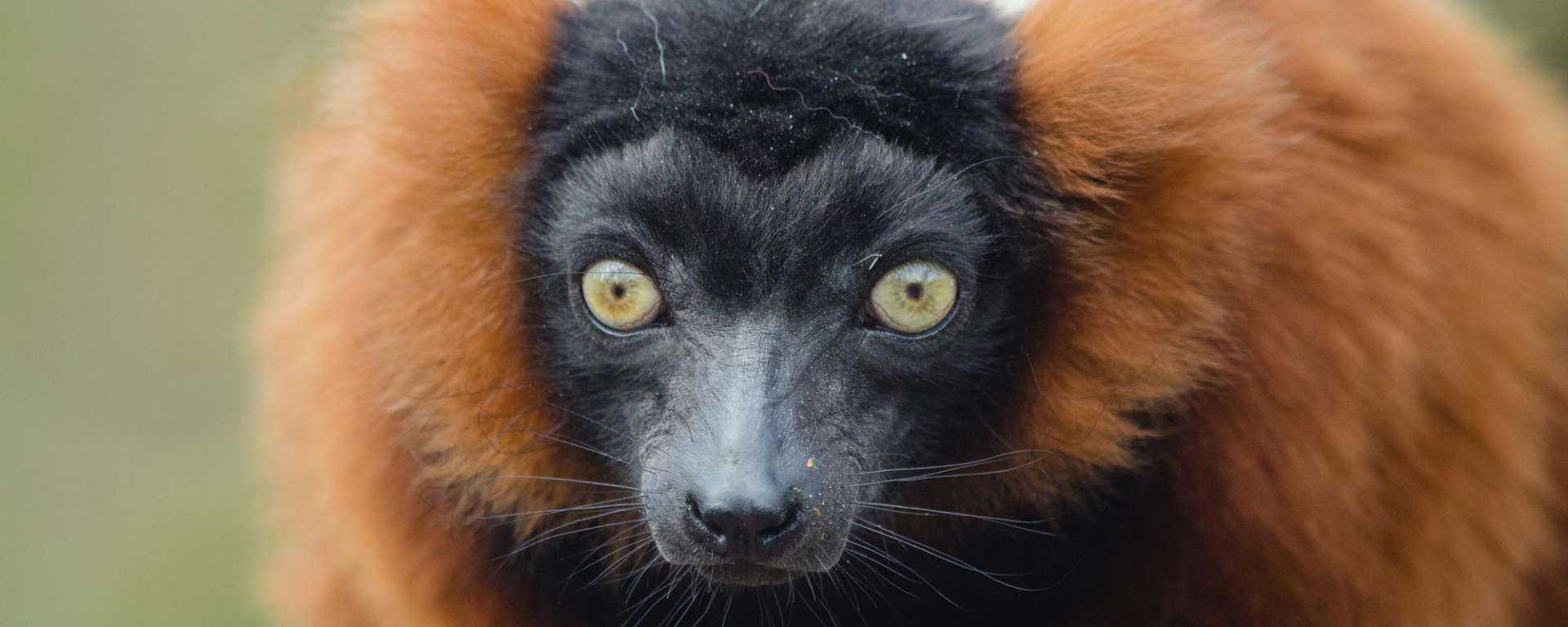Description
The red ruffed lemur, like the black and white ruffed lemur with whom they share a genus, is one of the largest members of the lemur family. They have long, soft coats of reddish-brown fur across most of their bodies as well as forming the distinctive “ruffs” around their ears from which they get their name. Their faces, tails, bellies, and appendages tend to be black in color. The have the prognathic, or fox-like snout characteristic many members of the Lemuridae family.
Classification
- Class
- Mammal
- Order
- Primates
- Family
- Lemuridae
- Genus
- Varecia
- Species
- V. rubra
- Conservation Status
- Critically Endangered
Key Facts
- Length
- 43-47 inches(~110-120cm)
- Weight
- 7.5-8lbs (~3.4-3.5kg)
The IUCN Red List describes Varecia rubra as a Critically Endangered species that is believed to have experienced an 80% decrease in population size within the last 30 years. Following a political crisis in 2009, an increase in illegal logging throughout Madagascar has contributed to catastrophic habitat loss for the species. This, in combination with unsustainable hunting pressures and an increased occurrence of cyclones are three primary factors negatively impacting this species.
Social Life
The social order of red ruffed lemurs varies based on geography and food abundance. In some areas and when food is abundant, they can be found in groups of 18 to 32 individuals. When food becomes scarce they will often part ways and form smaller groups of 2-5. They tend to be active during the day and will range far from their core home range in search of fruits and flowers. Border skirmishes do occur between social groups. While they don’t nest in the fashion of their black and white ruffed cousins, they will “park” their young in a common area within the core range to be watched over by other group members.
Habitat and Range
Red ruffed lemurs are restricted almost exclusively to the Masoala peninsula on the northeast coast of Madagascar. They inhabit deciduous tropical forests and are highly arboreal, spending much of their lives fifty feet or more off the ground.
Diet
Red ruffed lemurs are largely frugivorous and spend their days foraging for fruits, nectar, and pollen in the mature trees of primary growth forests. When fruits are in short supply, they will supplement their diet with leaves and seeds.
Lifespan
Ruffed lemurs typically live for 15-20 years.
Predators
The only known predator of the red ruffed lemur is the fossa.
Reproduction
Sexual maturity: Male: 2-4 years, Female: Around 2 years
Mating Season: May to July
Birth Season: September to November
Gestation: 90 days
No. of Young: up to 6 but usually 3
- Information
-
Description
The red ruffed lemur, like the black and white ruffed lemur with whom they share a genus, is one of the largest members of the lemur family. They have long, soft coats of reddish-brown fur across most of their bodies as well as forming the distinctive “ruffs” around their ears from which they get their name. Their faces, tails, bellies, and appendages tend to be black in color. The have the prognathic, or fox-like snout characteristic many members of the Lemuridae family.
Classification
- Class
- Mammal
- Order
- Primates
- Family
- Lemuridae
- Genus
- Varecia
- Species
- V. rubra
- Conservation Status
- Critically Endangered
Key Facts
- Length
- 43-47 inches(~110-120cm)
- Weight
- 7.5-8lbs (~3.4-3.5kg)
- Conservation
The IUCN Red List describes Varecia rubra as a Critically Endangered species that is believed to have experienced an 80% decrease in population size within the last 30 years. Following a political crisis in 2009, an increase in illegal logging throughout Madagascar has contributed to catastrophic habitat loss for the species. This, in combination with unsustainable hunting pressures and an increased occurrence of cyclones are three primary factors negatively impacting this species.
- Lifestyle
Social Life
The social order of red ruffed lemurs varies based on geography and food abundance. In some areas and when food is abundant, they can be found in groups of 18 to 32 individuals. When food becomes scarce they will often part ways and form smaller groups of 2-5. They tend to be active during the day and will range far from their core home range in search of fruits and flowers. Border skirmishes do occur between social groups. While they don’t nest in the fashion of their black and white ruffed cousins, they will “park” their young in a common area within the core range to be watched over by other group members.
Habitat and Range
Red ruffed lemurs are restricted almost exclusively to the Masoala peninsula on the northeast coast of Madagascar. They inhabit deciduous tropical forests and are highly arboreal, spending much of their lives fifty feet or more off the ground.
Diet
Red ruffed lemurs are largely frugivorous and spend their days foraging for fruits, nectar, and pollen in the mature trees of primary growth forests. When fruits are in short supply, they will supplement their diet with leaves and seeds.
Lifespan
Ruffed lemurs typically live for 15-20 years.Predators
The only known predator of the red ruffed lemur is the fossa.
Reproduction
Sexual maturity: Male: 2-4 years, Female: Around 2 years
Mating Season: May to July
Birth Season: September to November
Gestation: 90 days
No. of Young: up to 6 but usually 3

